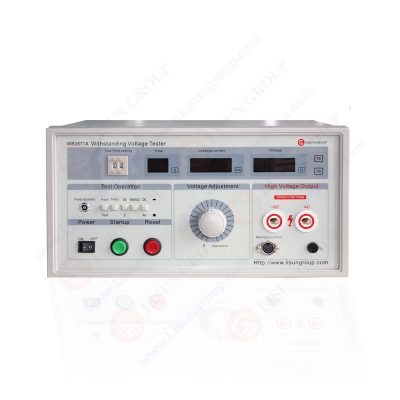
Overview of Withstand Voltage Testing
Withstand voltage testing evaluates the ability of various electrical devices, insulation materials, and insulation structures to withstand high voltage without compromising their insulation properties. This process involves applying a high voltage to the insulation material to assess its endurance, ensuring that the material can operate normally under working voltage or overvoltage conditions. The primary purpose of withstand voltage testing is to verify that the insulation performance of the product meets safety standards.
Basic Principle of Withstand Voltage Testing
The fundamental principle of withstand voltage testing is to apply a voltage higher than the normal working voltage to the insulator of the device under test and maintain it for a specified duration. If the insulation is adequate, the applied voltage will result in minimal leakage current. If the leakage current remains within the specified range during the test period, it can be concluded that the device is safe for normal operation.
Technical Specifications and Measurement Standards
The measurement standards for withstand voltage testing vary based on the technical specifications of the device under test. Generally, the test measures the leakage current between the live wire and the chassis. The standard testing voltage is twice the working voltage of the device plus 1000V. Some products may require higher test voltages. According to IEC61010, the test voltage must gradually rise to the required test value (e.g., 5kV) within 5 seconds and be maintained for at least 5 seconds. The measured leakage current is then compared with the standard threshold to determine if the insulation performance meets the criteria. After testing, the voltage must gradually decrease to zero within a specified time.
Importance of Withstand Voltage Testing
Withstand voltage testing is crucial for ensuring the safety of electrical devices and insulation materials. By evaluating the product’s safety under actual working conditions, it helps prevent electrical failures and safety hazards due to poor insulation performance, thereby protecting both personnel and equipment.
Withstand Voltage Testers and Their Importance
Withstand voltage testers, also known as electrical insulation strength testers, dielectric strength testers, breakdown devices, insulation strength testers, high-voltage testers, and withstand voltage testers, evaluate the insulation capacity of electrical devices by applying specified AC or DC high voltage between live parts and non-live parts (usually the casing).
Necessity of Withstand Voltage Testing
During prolonged operation, electrical devices endure not only their rated working voltage but also short-term overvoltages generated during operation. These overvoltages can exceed the rated working voltage by several times, potentially altering the internal structure of electrical insulation materials. When the overvoltage intensity reaches a certain level, the insulation may break down, leading to device malfunction and posing a risk to the operator’s safety.
WB2671B AC/DC Withstand Voltage Test
Key Indicators of Electrical Safety Testing
• AC/DC withstand voltage
• Insulation resistance
• Leakage current
• Ground resistance
Among these, AC/DC withstand voltage testing is a critical indicator for assessing the electrical safety performance of products under actual working conditions. Withstand voltage testers are mainly used for testing the withstand voltage of polyethylene-insulated power cables and the insulation withstand voltage of large power transformers. The application of ultra-low frequency high voltage for testing the withstand voltage of power cables is a new method.
Structure of Withstand Voltage Tester
Voltage Boosting Section: The voltage boosting section consists of a voltage regulator transformer, a step-up transformer, and switches for connecting and disconnecting the power supply.
• Voltage Regulator Transformer: Adjusts the input 220V voltage to output the corresponding voltage.
• Step-Up Transformer: Further increases the voltage output from the voltage regulator transformer.
• Power Control Switches: Controls the power connection and disconnection, allowing the user to adjust the output voltage of the step-up transformer.
Control Section: The control section includes current sampling circuits, timing circuits, and alarm circuits.
• Current Sampling: Monitors the current value in the tested circuit.
• Timing Circuit: Sets and controls the test duration, usually as a countdown.
• Alarm Circuit: Triggers an audible and visual alarm and immediately disconnects the power supply if the current in the tested circuit exceeds the set value.
Upon receiving the start signal, the control section immediately connects the power to the voltage boosting section. When the current exceeds the set value or the time is up, the power supply to the voltage boosting circuit is disconnected.
Display Circuit: Displays the output voltage value of the step-up transformer, the current value from the current sampling section, and the countdown time of the timing circuit.
Market Status and Technical Gap
Currently, most withstand voltage testers on the market adhere to the GB4706 (equivalent to IEC1010) standard and primarily feature benchtop instruments with single test indicators. They cannot meet users’ needs for comprehensive multi-indicator testing. Additionally, most existing testers use traditional testing methods with low accuracy, and their technical level and main performance indicators lag behind advanced international standards, making it difficult to fully satisfy modern electrical safety performance testing requirements.
Research and Development Directions
To meet the latest international standards, it is crucial to research and develop advanced technology-based withstand voltage testing systems with better performance indicators. Such systems can improve testing accuracy and provide more reliable data support for electrical safety performance testing, thereby promoting overall technological progress in the industry. Continuous technological innovation and research investment can narrow the gap with international advanced levels, enhance the competitiveness of domestic withstand voltage testers, and provide stronger support for electrical safety testing.
https://www.lisungroup.com/news/technology-news/the-necessity-and-application-of-withstand-voltage-testing-in-electrical-equipment-quality-control.html


Comments
Post a Comment